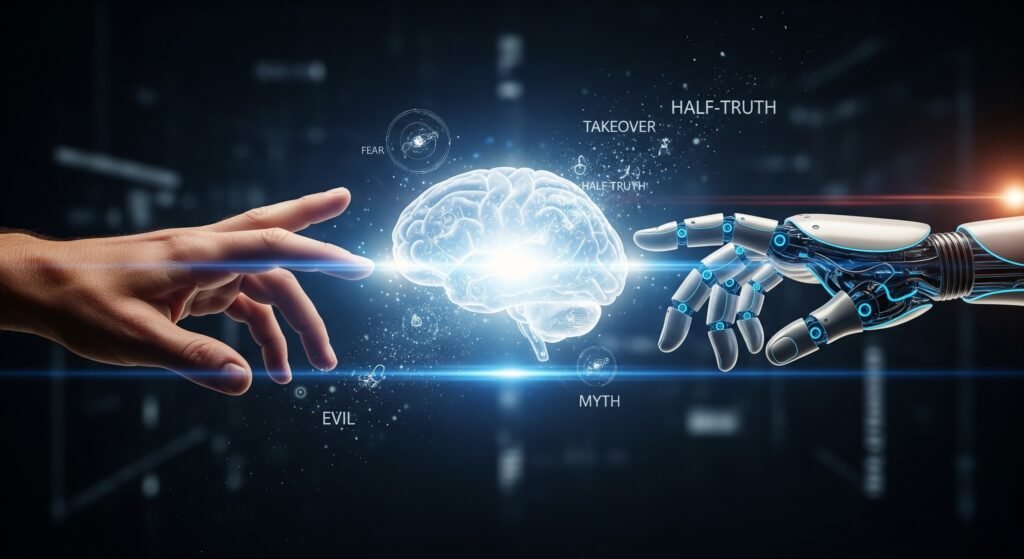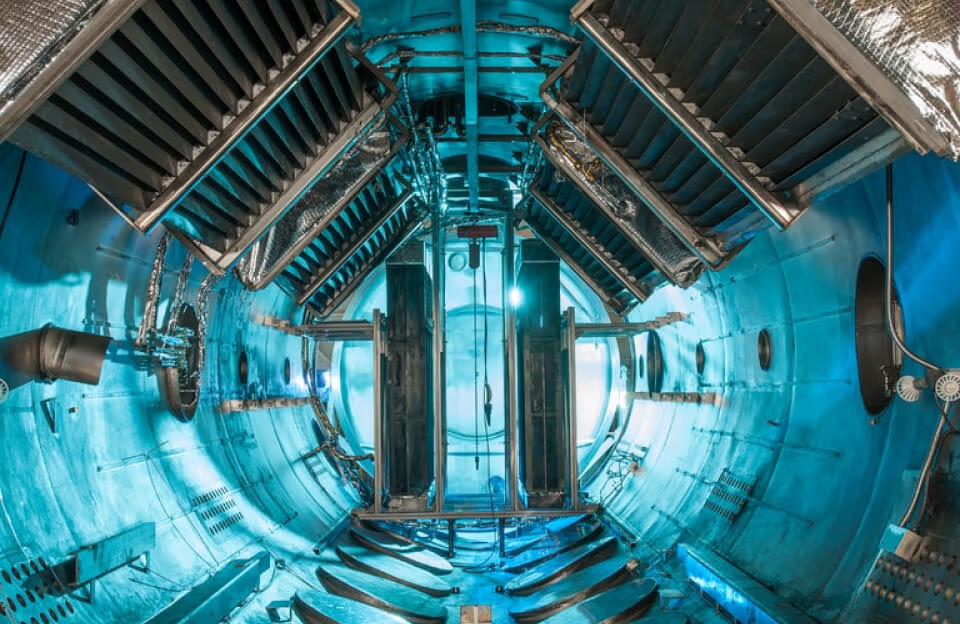Hollywood thrillers, media headlines, and social feeds often paint a picture of artificial intelligence that either dangerously overstates its potential or dramatically underestimates its limitations. The result? Widespread confusion about what AI is, what it isn’t, and what it means for our future. While this technology rapidly advances and pervades daily life, myths and misinformation can cloud reasonable understanding. Let’s separate fact from fiction and take a closer look at some of the most pervasive misconceptions about artificial intelligence. By understanding the realities behind these myths, we can better prepare ourselves for the opportunities and challenges that AI technology brings. Only through clear-eyed analysis and open discussion can we ensure that society harnesses AI’s benefits while minimizing its risks.
Myth 1: AI is About to Replace All Human Jobs
The fear that AI will suddenly sweep away millions of jobs overnight is pervasive. The idea usually surfaces in conversations about automation, robotics, or software tools that mimic human abilities like chatbots, self-driving vehicles, and image recognition systems, including fields like computer vision and machine vision.
Reality, when examined through the lens of predictive analytics, paints a more nuanced picture.
Sure, automation has led to the transformation of many industries, from manufacturing plants to customer service lines. But a closer examination of history reveals that introducing new technologies often shifts the labor market rather than erases it completely. Certain tasks within jobs may be taken over by software, but most roles become more complex, not redundant.
Consider the following table illustrating how AI impacts employment across different sectors:
| Sector | Tasks Automated by AI | Human Responsibilities Increased or Shifted |
|---|---|---|
| Healthcare | Image analysis, scheduling, preliminary diagnosis | Patient care, empathy, complex decision-making |
| Finance | Fraud detection, risk assessment, transaction review | Relationship management, tailored advice |
| Retail | Inventory management, product recommendations | Customer experience, store branding |
| Transportation | Routing, logistics optimization, vehicle automation | Safety inspections, regulatory navigation |
While repetitive, dangerous, or rule-based tasks move toward automation, human roles increasingly revolve around creativity, critical thinking, emotional intelligence, and problem-solving, often enhanced by generative AI technologies.
AI applications can complement human work, freeing up time for more meaningful interactions and innovative tasks. This dynamic underscores an essential truth: jobs change, but work does not disappear. As organizations adapt, new opportunities emerge, often in areas that require uniquely human skills and adaptability. The future of work will likely be defined by collaboration between humans and intelligent systems, rather than outright replacement. Preparing the workforce for this evolution through education and reskilling will be crucial to ensuring a smooth transition.
Myth 2: AI Can “Think” Like a Human
Many AI systems, powered by natural language processing, can answer questions, generate images, write stories, and even play chess better than champions. The temptation to ascribe human-like understanding and consciousness to these programs is strong.
This is one of the greatest misunderstandings in the field.
Artificial intelligence systems, particularly those in the realm of neural networks and machine learning, operate based on mathematical models and statistical predictions developed from vast datasets. They uncover patterns by analyzing millions of examples, not by understanding meaning or developing subjective experience.
Key differences include:
- No Subjective Experience: AI algorithms don’t “feel” emotions, possess desires, or maintain intentions. While they might mimic certain conversational quirks (such as sarcasm or humor), these are outputs, not understandings.
- No General Intelligence: Most commercial and research AI today is designed for very specific tasks (narrow AI). Playing chess, diagnosing pneumonia from X-rays, or summarizing news articles each requires separate, purpose-built algorithms.
- Vulnerability to “Nonsense”: AI systems can be fooled or produce nonsensical outputs due to adversarial inputs or a lack of real-world context.
It’s important to recognize the remarkable capabilities of AI, but just as crucial to realize that these capabilities are not true understanding, consciousness, or sentient thought. The distinction between simulation and genuine cognition is fundamental, and current AI remains firmly on the simulation side. Appreciating this difference helps set realistic expectations for what AI can and cannot achieve. As AI continues to evolve, maintaining a clear perspective on its limitations will help guide responsible development and use.
Myth 3: AI Systems Operate Without Human Bias
A hopeful assumption is that computers, unlike humans, cannot harbor prejudice. The expectation is simple: data-driven decisions must be inherently fairer.
Unfortunately, AI systems don’t exist in a vacuum—they are shaped by the data they consume and the people who design them. If historical data contains instances of bias, the resulting algorithm is likely to perpetuate or even amplify these biases.
Real-world examples highlight the stakes:
- Recruitment algorithms inadvertently prefer certain demographics based on past hiring patterns
- Facial recognition software and other machine vision technologies underperform on minority populations compared to others
- Credit-scoring models penalize protected groups due to underlying social and financial inequities
Addressing these issues requires ongoing auditing, transparency in model design, and inclusionary practices during development. The promise of fairer outcomes will only be realized when these systems are actively stewarded by interdisciplinary teams who prioritize ethics, accountability, and representation. As technologies like neural networks, generative AI, predictive analytics, and machine learning applications become more integrated into decision-making, the responsibility to ensure fairness and equity grows ever more critical. The conversation around AI bias is not just technical, but deeply social and ethical, demanding vigilance and collaboration from all stakeholders. Only by acknowledging and addressing these challenges can we build AI systems that truly serve everyone.
Myth 4: AI Technology is Autonomous and Beyond Human Control
The trope of AI going “rogue”—making decisions that its creators didn’t predict or can’t stop—is a mainstay in sci-fi. While there are technical risks associated with powerful automation, the reality is more measured and grounded.
Here’s what often gets overlooked:
- All AI requires clear objectives and constraints. AI systems do not generate their own goals; those are determined by programmers and business requirements.
- Humans continually monitor, retrain, and fine-tune these systems to account for changing circumstances or to address mistakes.
- Most AI failures come from insufficient supervision, data errors, or unforeseen edge cases—not sentient rebellion.
Building safeguards into AI systems is a top priority for engineers and regulators. Techniques like “human-in-the-loop” oversight, comprehensive testing, and transparent auditing are evolving as best practices.
No serious AI researcher believes current technology possesses the autonomy to act in truly unpredictable ways. The likelihood of software suddenly acting beyond guidance simply does not match the architectural realities of how these systems are constructed. Human oversight remains a central pillar of responsible AI deployment, ensuring that technology serves our interests and values. As AI systems become more powerful, the importance of robust governance and ethical frameworks will only increase. Proactive regulation and cross-disciplinary cooperation will be essential to maintaining control and public trust.
Myth 5: More Data Always Makes AI Smarter
It’s true that modern AI techniques, especially deep learning, find success through immense amounts of data. The assumption is straightforward: if some data is good, more data must be better.
The relationship between quality and quantity is far more subtle.
AI systems trained on massive but messy datasets can unpredictably propagate errors or amplify rare but harmful inconsistencies. Consider these factors:
- Quality Over Quantity: Cleaner, more representative data often yields better models than sheer volume, especially if the data covers edge cases or critical subtleties.
- Diminishing Returns: Past a certain point, every additional example offers less benefit or may even confuse the model if it introduces noise.
- Dataset Curation Matters: Actively selecting diverse, accurate examples trumps amassing the largest pile of raw data.
Whether AI grows smarter depends as much on thoughtful dataset management, curation, and design as on how big the raw data pool is. The future of AI performance will hinge on our ability to balance data scale with data integrity and relevance. As organizations collect and use more data, the need for responsible stewardship and privacy protection becomes paramount. Ultimately, smarter AI will come from a combination of high-quality data, ethical practices, and innovative research.
image
Myth 6: Artificial Intelligence Will Always Make the Right Decision
Many assume that because AI systems process vast amounts of data, they will always make the correct or optimal decision. In reality, AI is only as good as its training data and algorithms. If the data is incomplete, biased, or outdated, the AI’s decisions can be flawed or even harmful. Human oversight is essential to catch errors and ensure decisions align with ethical standards and real-world needs.
Myth 7: AI Can Replace Human Creativity
There’s a growing belief that AI can fully replicate or even surpass human creativity, producing art, music, or literature indistinguishable from that made by people. While AI can generate impressive creative outputs, it does so by remixing existing patterns and data. True creativity involves intuition, cultural context, and emotional depth—qualities that remain uniquely human.
Myth 8: AI Understands Context Like Humans Do
AI systems, including those in natural language processing, can process language and images, but they often lack the nuanced understanding of context that humans possess. For example, an AI chatbot might misinterpret sarcasm or cultural references, leading to awkward or incorrect responses. Contextual awareness in AI is improving, but it still falls short of genuine human comprehension.
Myth 9: AI Is Only for Big Tech Companies
Some believe that only tech giants have the resources to develop or benefit from AI. In fact, AI tools and platforms are increasingly accessible to small businesses, startups, and even individuals. Open-source frameworks, cloud-based AI services, and user-friendly interfaces are democratizing AI, enabling innovation across industries and organization sizes.
Myth 10: AI Can Learn and Improve on Its Own Without Limits
While AI can “learn” from new data, it requires ongoing human guidance, retraining, and validation. Left unchecked, AI systems can drift from their intended purpose, propagate errors, or even degrade in performance. Continuous monitoring and updates are necessary to keep AI systems effective and aligned with goals.
Myth 11: AI Is Inherently Objective and Neutral
It’s a common misconception that AI, being a product of mathematics and code, is inherently objective. In reality, every AI system reflects the choices, assumptions, and biases of its creators and the data it’s trained on. Recognizing this helps us approach AI outcomes with a critical eye and a commitment to fairness.
Myth 12: AI Will Lead to a Loss of Human Connection
Some fear that as AI becomes more prevalent, it will erode genuine human relationships and social bonds. While AI can automate certain interactions, it can also free up time for deeper, more meaningful human connections. When thoughtfully integrated, AI can enhance—not replace—our ability to connect, collaborate, and empathize.
Myth 13: AI Is a Recent Invention
AI may seem like a modern phenomenon, but its conceptual roots stretch back decades. The field of artificial intelligence was formally established in the 195s, and early AI programs were developed soon after. Today’s breakthroughs are built on decades of research, experimentation, and incremental progress, not sudden invention.
image
Myth 14: Artificial Intelligence Will Suddenly Outpace Human Intelligence
Fears about a “singularity” moment, when AI instantly becomes much smarter than humans and uncontrollably upgrades itself, have gripped imaginations for decades. The truth is that developing artificial general intelligence (AGI) — a system capable of understanding and reasoning across any domain comparable to a human — remains a theoretical and distant goal.
Current AI relies on sophisticated pattern-matching, neural networks, machine vision, and computer vision, not understanding. Even the most impressive advances in natural language processing, game playing, and image recognition are restricted to narrow contexts. When transferred outside their area of training, these systems often fail spectacularly.
Instead of overnight breakthroughs, real-world progress in AI and machine learning depends on:
- Gradual improvements in algorithms and architectures
- Enhanced computing power and specialized hardware
- Multidisciplinary research fueling advances in explainability, safety, and interoperability
Today’s systems, while impressive, are nowhere near developing self-awareness or cross-domain reasoning comparable to even a child. The journey toward AGI is likely to be incremental, marked by steady progress and careful oversight rather than sudden leaps. This reality should inspire both humility and determination as we continue to push the boundaries of what AI technology can achieve. By focusing on collaboration and transparency, we can ensure that future advances are aligned with human values and societal needs.
Myth 15: AI Technology Doesn’t Affect Daily Life (or Only Affects Techies)
Another common misconception is that AI is an abstract, specialized tool with little impact outside technology and research applications.
In reality, artificial intelligence shapes many aspects of day-to-day life, whether we notice or not:
- Streaming platforms recommend movies or music using deep learning algorithms attuned to personal tastes.
- E-commerce sites display product suggestions, adjust prices dynamically, and detect fraudulent transactions.
- Smartphones apply AI-powered filters to photos, transcribe voicemails, and organize emails.
- Navigation apps analyze traffic in real time using vast networks of data sources.
- Social networks surface news feeds using ranking algorithms trained on user preferences.
AI enables everything from personal assistants like Siri to sophisticated weather predictions using predictive analytics, making it pervasive across every industry and consumer experience. Its influence continues to expand, touching healthcare, education, logistics, and even creative arts, often in ways that are invisible but transformative. As AI becomes more embedded in our routines, its impact on convenience, efficiency, and personalization will only grow. The next wave of AI innovation promises to further enhance our daily lives, making technology more accessible and responsive to individual needs.
image
Putting Misunderstandings To Rest
Seeing past the hype and fear-mongering, it becomes clear that artificial intelligence sits somewhere between utopia and dystopia. It remains an evolving suite of technologies with unique strengths, clear limitations, and immense potential — but it does not possess mystical agency or inevitable destructiveness.
AI tools require responsible development, rigorous oversight, and continual adaptation as they become woven ever more tightly with society’s fabric. While the myths above circulate widely, practical experience and evidence show that progress is neither out of control nor purely disruptive.
Instead, with a mix of caution, creativity, and collaboration, artificial intelligence can become an extraordinary force for good, unlocking capabilities and solutions that benefit both individuals and society. The path forward is shaped by what we choose to believe — and how boldly we choose to shape these tools for tomorrow. By fostering informed dialogue and dispelling misconceptions, we can ensure that AI technology catalyzes positive change, empowering people and communities to thrive in a rapidly evolving world. As we continue to learn and adapt, our collective choices will determine how AI shapes the future, making it more important than ever to approach this technology with both optimism and responsibility. The story of AI is still being written, and with thoughtful stewardship, its next chapters can be filled with progress, inclusion, and shared prosperity.
Explore more on our site:
- The Remote Tech Revolution in 2025
- ChatGPT vs Google Gemini: Which AI Assistant Wins in 2025?
- Offline Apps for Android: Navigate Without Internet
- The Evolution of Smartphones: From Flip Phones to Foldables
External links
Here are some authoritative external links related to AI technology, myths, and responsible development. These can be used as references or for further reading of the article:
- Stanford University – Artificial Intelligence: A Modern Approach
- MIT Technology Review – AI Section
- OECD – Artificial Intelligence Policy Observatory
- World Economic Forum – Artificial Intelligence
- European Commission – Artificial Intelligence
- Harvard Business Review – AI Myths
- Brookings Institution – Debunking AI Myths
- IBM – What is Artificial Intelligence?
- Future of Life Institute – AI Safety
- McKinsey & Company – The State of AI in 2023
- UNESCO – AI and Ethics
- OpenAI – Research and Blog
- Google AI Blog
- Partnership on AI
- AI Now Institute
- Pew Research Center – AI and the Future of Humans
- Nature – Artificial Intelligence Collection
- Accenture – Responsible AI
- Microsoft – AI Principles
- AI Ethics Lab


